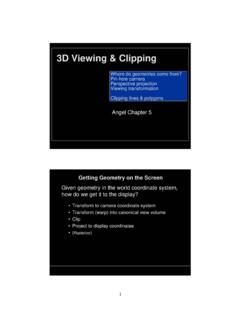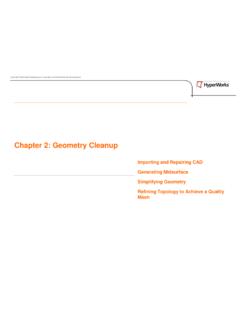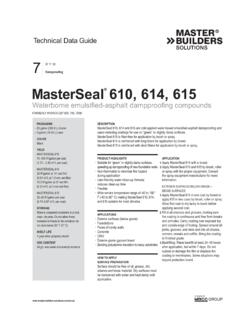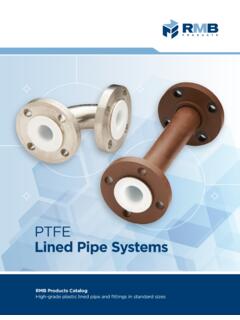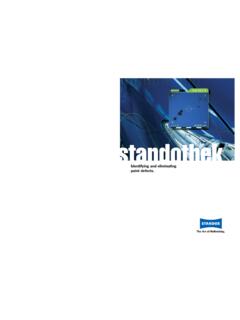Transcription of Permeation & Degradation Data - Environment, Health and …
1 Permeation & Degradation Data8thEDITIONP ermeation & Degradation DataIntroduction to the 8th EditionWhen reviewing thefollowing recommendations,remember that tests areconducted under laboratoryconditions, and that actualworkplace conditions usuallydictate a combinationofperformance product s resistance tocuts, punctures, and abrasionmust also be taken intoaccount as a critical glove with excellentpermeation resistance maynot be adequate if it tears orpunctures easily. Alwaysfactor in the physicalperformance requirementsof the job or applicationwhen selecting a chemical-resistant s ASTM standard Permeation anddegradation tests arepresented on the followingpages as an aid in determiningthe general suitability ofvarious products for usewith specific the conditions ofultimate use are beyondour control, and because wecannot run Permeation testsin all possible workenvironments and across allcombinations of chemicalsand solutions, theserecommendations areadvisory only.
2 THESUITABILITY OF THEPRODUCT FOR ASPECIFIC JOB MUST BEDETERMINED BYTESTING BY of Key TermsPermeationis a processby which a chemical canpass through a protectivefilm without going throughpinholes, pores, or othervisible openings. Individualmolecules of the chemicalenter the film, and squirm through by passing betweenthe molecules of the glovecompound or film. In manycases the permeated materialmay appear unchanged tothe human permeationcan be described in simpleterms by comparing it towhat happens to the air ina balloon after several there are no holes or defects, and theballoon is tightly sealed, theair gradually passes through(permeates) its walls andescapes.
3 This simple exampleuses gas Permeation , butthe principle is the samewith liquids or data arepresented in two values:Breakthroughtime times(min.) are the timesobserved from the start ofthe test to first detection ofthe chemical on the otherside of the sample (for testmethodology, see the outsideback cover of this guide).These times represent howlong a glove can be expectedto provide effectivepermeation resistance whentotally immersed in the rates arethe highest flow ratesrecorded for the permeatingchemicals through the glovesamples during a six-houror eight-hour test. Thesequalitative ratings arecomparisons of permeationrates to each areduction in one or morephysical properties of aglove material due tocontact with a glove materials maybecome hard, stiff, orbrittle, or they may growsofter, weaker, and swell toseveral times their originalsize.
4 If a chemical has asignificant impact on thephysical properties of aglove material, itspermeation resistance isquickly impaired. For thisreason, glove/chemicalcombinations rated Poor are usually not tested forpermeation resistance, andcombinations rated NotRecommended are nevertested for permeationresistance. Please note,however, that permeationand Degradation do notalways overallDegradation Ratingfor eachchemical is explained in How To Read The Charts. Why is a product with a shorter breakthrough time sometimes given a better rating than one with a longer breakthrough time?One glove has a breakthrough time of just 4minutes. It is rated very good, while another with abreakthrough time of 30 minutes is rated only fair.
5 Why? The reason is simple:in some cases the rateismore significant than the connecting two hoses of the samelength but different diameters to a faucet using a Y connector. When you turn on the water, whathappens? Water goes through the smaller hose firstbecause there is less space inside that needs to when the water finally gets through thelarger hose it really gushes only a fewminutes, the larger hose will discharge much morewater than the smaller one, even though the smallerone started situation is similar with gloves. Acombination of a short breakthrough time and a lowpermeation rate may expose a glove wearer to lesschemical than a combination of a longerbreakthrough time and a much higher breakthroughrate, if the glove is worn long Resistance Guide for Ansell Chemical Resistant Gloves> Greater than (time)< Less than (time)Key to Permeation BreakthroughE Excellent;fluid has very little degrading Good;fluid has minor degrading Fair;fluid has moderate degrading Poor;fluid has pronounced degrading Degrades the outer layer and delaminates Not Recommended.
6 Fluid has severe degrading to Degradation RatingsDegradation and PermeationLaminated LCPTMFilmBarrier 2-100( mm)NitrileSol-Vex 37-165(22 mm)Neoprene Unsupported29-865(18 mm)Polyvinyl Alcohol SupportedPVATMP olyvinyl Chloride SupportedSnorkel Natural Rubber LatexCanners 343(20 mm)Neoprene/Latex BlendChemi-Pro 224(27 mm)Butyl UnsupportedChemTek 38-320(20 mm)Viton/Butyl UnsupportedChemTek 38-612(12 mm)Specific Gloves Used for TestingThree categories of data are represented for each Ansell product and corresponding chemical:1) overall Degradation resistance rating;2) Permeation breakthrough time, and3) Permeation for Color-CodingA glove-chemical combination receives GREENif either set of the following conditions is met: The Degradation Rating is Excellent or Good The Permeation Breakthrough Time is 30 minutes or greater The Permeation Rate is Excellent,Very Good,or GoodOR The Permeation Rating is not specified The Permeation Breakthrough Time is 240 minutes or greater The Degradation Rating is Excellent,or GoodA glove-chemical combination receives REDif either set of the following conditions is met.
7 The Degradation Rating is Poor or Not RecommendedOR The Degradation Rating is Degrades with Delamination (DD) The Permeation Breakthrough Time is less than 20 minutesAll other glove-chemical combinations receive YELLOW .In other words, any glove-chemical combination not meeting either set of conditions required for Green,and not having aRed Degradation rating of either Poor or Not Recommended,receives a YELLOW to Read the Charts8thEDITIONDD is a new Degradation rating that applies toViton/butyl gloves versus certain chemicals. It means"Degrades and Delaminates".If a chemical causessevere swelling of Viton but has little effect on butyl,the adhesion between these two rubber layers canbe overcome under the relatively severe continuousliquid contact that is part of an ASTM or CENstandard Permeation end result of thisstress is Viton "blisters" or even complete damage is likely to be cases such as these the butyl layer isproviding most of the if the enduse involves only the possibility of splash orintermittent contact so that the Viton layer neverabsorbs enough chemical to swell and delaminate.
8 Viton/ butyl gloves might still be the best ultimate decision on when to use plain butyland when to use Viton/ butyl will depend on theoverall chemical mix in your facility and on thedegree of exposure to TestingAnsell conducts permeationtesting in accordance withASTM Method F 739 standards. A specimen is cutfrom the glove and clampedinto a test cell as a barriermembrane (see illustration).The exterior side of thespecimen is exposed to ahazardous intervals, the unexposedMethodology interior side of the test cellis checked for the presenceof the permeated chemicaland the extent to which itmay have permeated theglove standard allows avariety of options in analyticaltechnique and Ansell,dry nitrogenis the most common mediumand gas chromatographywith FID detection is the mostcommon analytical Research Departmentalso uses liquids such as distilled water and hexane ascollecting media,and techniques such as conduc-tivity,colorimetry, and liquidchromatography for analysisof the collecting Edition Form No.
9 2008 Ansell Healthcare. All Rights TestingPatches of the test material are cut from patches areweighed and measured,andthen completely immersedin the test chemical for 30minutes. The percentage ofchange in size is determined,and the patches are thendried to calculate the percentage of weightchange. Observed physicalchanges are also are based on thecombined Hongo, Bunkyo-ku,Tokyo 113-0033;Tel.+81 3 5805 3741 Fax.+81 3 5800 6171 AUSTRALIA-Level 3,678 Victoria St.;Richmond,Vic, 3121;Tel.+61 3 9270 7270 Fax.+61 3 9270 ,55;1070 Brussels;Tel.+32 2 528 74 00 Fax.+32 2 528 74 Lauder St.;Cowansville Quebec J2K 2K8;Tel.+800 363 8340 Fax.+888 267 dos Estados 4530/4576;Santo Andre-SP-CEP 09220-570;CNPJ ;Tel.
10 +55 19 3129 0031 Fax.+55 19 3129 0032 MEXICO-Sierra de Zimap n 4-69; del Sol, 76047;Quer taro, Qro.;Tel.+52 442 248 1544 Fax.+52 442 248 3133 UNITEDSTATES-200 Schulz Dr.; Red Bank,NJ 07701; 800 0444 800 0445 Permeation & Degradation DataIntroduction to the 8th EditionWhen reviewing thefollowing recommendations,remember that tests areconducted under laboratoryconditions, and that actualworkplace conditions usuallydictate a combinationofperformance product s resistance tocuts, punctures, and abrasionmust also be taken intoaccount as a critical glove with excellentpermeation resistance maynot be adequate if it tears orpunctures easily. Alwaysfactor in the physicalperformance requirementsof the job or applicationwhen selecting a chemical-resistant s ASTM standard Permeation anddegradation tests arepresented on the followingpages as an aid in determiningthe general suitability ofvarious products for usewith specific the conditions ofultimate use are beyondour control,and because wecannot run Permeation testsin all possible workenvironments and across allcombinations of chemicalsand solutions, theserecommendations areadvisory only.
